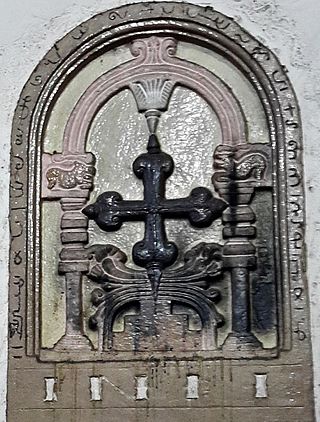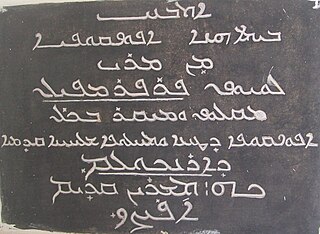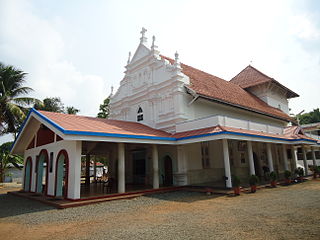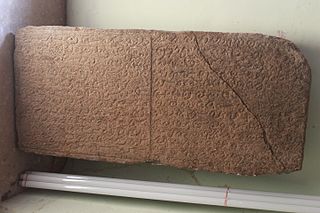
The Syro-Malabar Church, also known as the Syro-Malabar Catholic Church, is an Eastern Catholic Church based in Kerala, India. It is a sui iuris (autonomous) particular church in full communion with the Holy See and the worldwide Catholic Church, with self-governance under the Code of Canons of the Eastern Churches (CCEO). The major archbishop presides over the entire church. The incumbent Major Archbishop is Raphael Thattil, serving since January 2024. The Syro-Malabar Synod of Bishops canonically convoked and presided over by the major archbishop constitutes the supreme authority of the church. The Major Archiepiscopal Curia of the church is based in Kakkanad, Kochi. Syro-Malabar is a prefix reflecting the church's use of the East Syriac Rite liturgy and origins in Malabar. The name has been in usage in official Vatican documents since the nineteenth century.

The Synod of Diamper (Udayamperoor Synod) (Malayalam: ഉദയംപേരൂർ സൂനഹദോസ്, romanized: Udayampērūṟ Sūnahadōs), held at Udayamperoor (known as Diamper in non-vernacular sources) in June 1599, was a diocesan synod, or council, that created rules and regulations for the ancient Saint Thomas Christians (also known as Mar Thoma Nasranis) of the Malabar Coast, a part of modern-day Kerala state, India, formally subjugating them and downgrading their whole Metropolitanate of India as the Diocese of Angamale, a suffragan see to the Archdiocese of Goa administered by Latin Church Padroado missionaries. This synod also introduced forced Liturgical Latinisation and the eschewal of local practices and beliefs, leading to a significant ecclesial protest by Saint Thomas Christians known as Coonan Cross Oath and a subsequent schism in the mid-17th century.

The Archeparchy of Changanacherry is a Syro-Malabar Catholic archeparchy with an area of 24,595 km2 comprising the districts of Kottayam, Alappuzha, Pathanamthitta, Kollam, and Thiruvananthapuram in Kerala, and also Kanyakumari district in Tamil Nadu. It is one of the largest Catholic dioceses in India in terms of area. Joseph Perumthottam is the current Metropolitan Archbishop, serving since 2007. Thomas Tharayil has been the auxiliary bishop since 2017. Suffragan eparchies of the Changanassery archeparchy includes Palai, Kanjirappally-Nilackal, and Thuckalay-Thiruvithancode.

The Major Archeparchy of Ernakulam–Angamaly is the major archeparchy and the see of the Major Archbishop of the Syro-Malabar Catholic Church. It has been the major archeparchy since 1992 when the Syro-Malabar Catholic Church was elevated to the status of a major archiepiscopal church with Ernakulam-Angamaly as the primatal see. The major archbishop of Ernakulam-Angamaly is the main bishop of the jurisdiction, at the same time the head of the Syro-Malabar Catholic Church. The eparchies of Kothamangalam and Idukki are the two suffragan eparchies of the major archeparchy.

The Eparchy of Irinjalakuda is a suffragan eparchy in the ecclesiastical province of the metropolitan Syro-Malabar Catholic Archeparchy of Thrissur in Kerala state's Thrissur District, southern India.It is part of the Syro-Malabar Church.

The history of the Church of the East in India is dated to 52 AD by apocryphal sources and to the 9th century by the Quilon Syrian copper plates, the latter of which is considered the earliest reputable dating for Christians in the Indian subcontinent.

This is a timeline of the history of the Syro-Malabar Catholic Church in India.

Palliveettil Chandy also known as Parambil Chandy was a bishop of the Catholic Saint Thomas Christians. He is also the first known native Indian bishop.

Metropolitanate of India was an East Syriac ecclesiastical province of the Church of the East, at least nominally, from the seventh to the sixteenth century. The Malabar region (Kerala) of India had long been home to a thriving Eastern Christian community, known as the Saint Thomas Christians. The community traces its origins to the evangelical activity of Thomas the Apostle in the 1st century. The Christian communities in India used the East Syriac Rite, the traditional liturgical rite of the Church of the East. They also adopted some aspects of Dyophysitism of Theodore of Mopsuestia, often inaccurately referred as Nestorianism, in accordance with theology of the Church of the East. It is unclear when the relation between Saint Thomas Christian and the Church of the East was established. Initially, they belonged to the metropolitan province of Fars, but were detached from that province in the 7th century, and again in the 8th, and given their own metropolitan bishop.

St. Thomas Cathedral is the Syro Malabar Catholic cathedral of the eparchy of Irinjalakuda in India. It presently exists under the nomenclature and the Canonical Status as Cathedral in the Wake of the Origin of the New Eparchy, effected by the amalgamation of the two independent and important parishes of the locality, namely, St. George’s Forane Church and St. Mary’s church, which were amicably situated side by side for about a century.

The Saint Thomas Christian denominations are Christian denominations from Kerala, India, which traditionally trace their ultimate origins to the evangelistic activity of Thomas the Apostle in the 1st century. They are also known as "Nasranis" as well. The Syriac term "Nasrani" is still used by St. Thomas Christians in Kerala. It is part of the Eastern Christianity institution.

Gīwargīs of the Cross, also spelled Geevarghese of Cross and George of Cross, was an archdeacon (arkkadyakon) and leader of the Saint Thomas Christian community of India. He was the son of the elder brother of Giwargis of Christ. By the last year of Bishop Mar Abraham, he became the Archdeacon. After the Bishop's death in 1597, he led the Indian Church. He led the church amidst Portuguese intervention. The Synod of Diamper (1599) was held during his time. In 1601, Francis Ros became Bishop, appointed by the Archbishop of Goa, Aleixo de Menezes. In the beginning there was cordiality, but the deliberate downgrading of Angamaly and the inertia of Bishop Ros frustrated him. When the Archdeacon protested, Ros excommunicated him. In 1615, the Bishop and Archdeacon reconciled each other, but again fell out later. The next Bishop, Etienne de Brito, also did not recognize the Archdeacon's ecclesiastical status. He led the church in a period of severe stress and turmoil, and held it together. After his time and his brother's time the root family of Pakalomattam became heirless. The only son shifted residence to Alappatt house. He is believed to have been buried in the forefront of Pakalomattam Thravadu (Kuravilangadu).

Mar Hormizd Cathedral, locally known as the Eastern Church of Angamaly or the Cathedral Church, is a Syro-Malabar church in Angamaly, India. It was created cathedral in 1577 by Mar Abraham, the last East Syriac Metropolitan to reach Malabar Coast. It is one of the oldest and is historically the most important of the three ancient Syrian churches in Angamaly. It is dedicated to Mar Hormizd, a seventh-century East Syriac saint.
Francisco Ros, S.J (1559–1624) was a Jesuit prelate who served as the first Archbishop of Angamaly-Cranganore, associated with the Saint Thomas Christians in the early modern Malabar in South India.

St. Mary's Jacobite Syrian Soonoro Cathedral is an ancient Jacobite Syrian church located in Angamaly. Founded in 1564 by Archdeacon Giwargis of Christ, it is one of the most prominent and ancient Syriac Orthodox churches in Kerala. In the seventeenth century it was the residence of Archdeacon Thomas Parambil, who eventually got consecrated as bishop Mar Thoma I. It was initially the seat of the Archdeacon and later the Marthoma methrans, the local heads of the Malankara Church and hence held an important position in the church for several centuries.

The Metropolitan Archdiocese of Angamaly was an ecclesiastical territory of the Chaldean Catholic Church with jurisdiction in Malabar, India. It came into existence as a Catholic continuation of the Ecclesiastical Province of India of the Church of the East following the schism of 1552. It was established in 1565 continued to exist till 1599 when it was ultimately suppressed by the colonial Synod of Diamper in 1599 and replaced by the Portuguese Padroado administered Diocese of Angamaly suffragan to the Padroado Primatal Archdiocese of Goa. The brief and turbulent history of the archdiocese is noted for the its two archbishops, namely Joseph Sulaqa and Abraham, who were the last Persian prelates to govern the undivided Saint Thomas Christian community in South India.
Angamāly Padiyōla is a historic declaration of the Syrian Catholic/ Syro Malabar (Paḻayakūṟ) Saint Thomas Christians proclaimed in 1787 at the Great Church of Saint George in Angamāly. This document made a strong appeal to the pope for the consecration of a native bishop for the community and demanded autonomy for their Church which was forcibly brought under the Latin Church's jurisdiction.

The Paḻayakūṟ, also known as Romo-Syrians or Syrian Catholics of Malabar, are the East Syriac denominations of the Saint Thomas Christian Church, which claim ultimate apostolic origin from the Indian mission of Thomas the Apostle in the 1st century AD.

Jacob Pakalomattam was an Archdeacon of the Saint Thomas Christian community in India in the years preceding the Synod of Diamper in 1599. He was a native of Muttuchira and belonged to the Pakalomattam dynastic family. His activities were based in the Church of Ruha d'Qudisha in Muttuchira. He owed his staunch allegiance to the traditionalist Eliah Patriarchate of the Church of the East and Metropolitan Mar Shemon, who was sent to India by Patriarch Eliya VI Barmama. He protested against the Latinising attempts of the Portuguese Padroado and resisted the Chaldean Catholic attempts of reconciliation led by Joseph Sulaqa and Abraham of Angamaly. Throughout his archdeaconate, he is known to have rebelled against the Chaldean Catholic archdeacons including Givargis of Cross.















